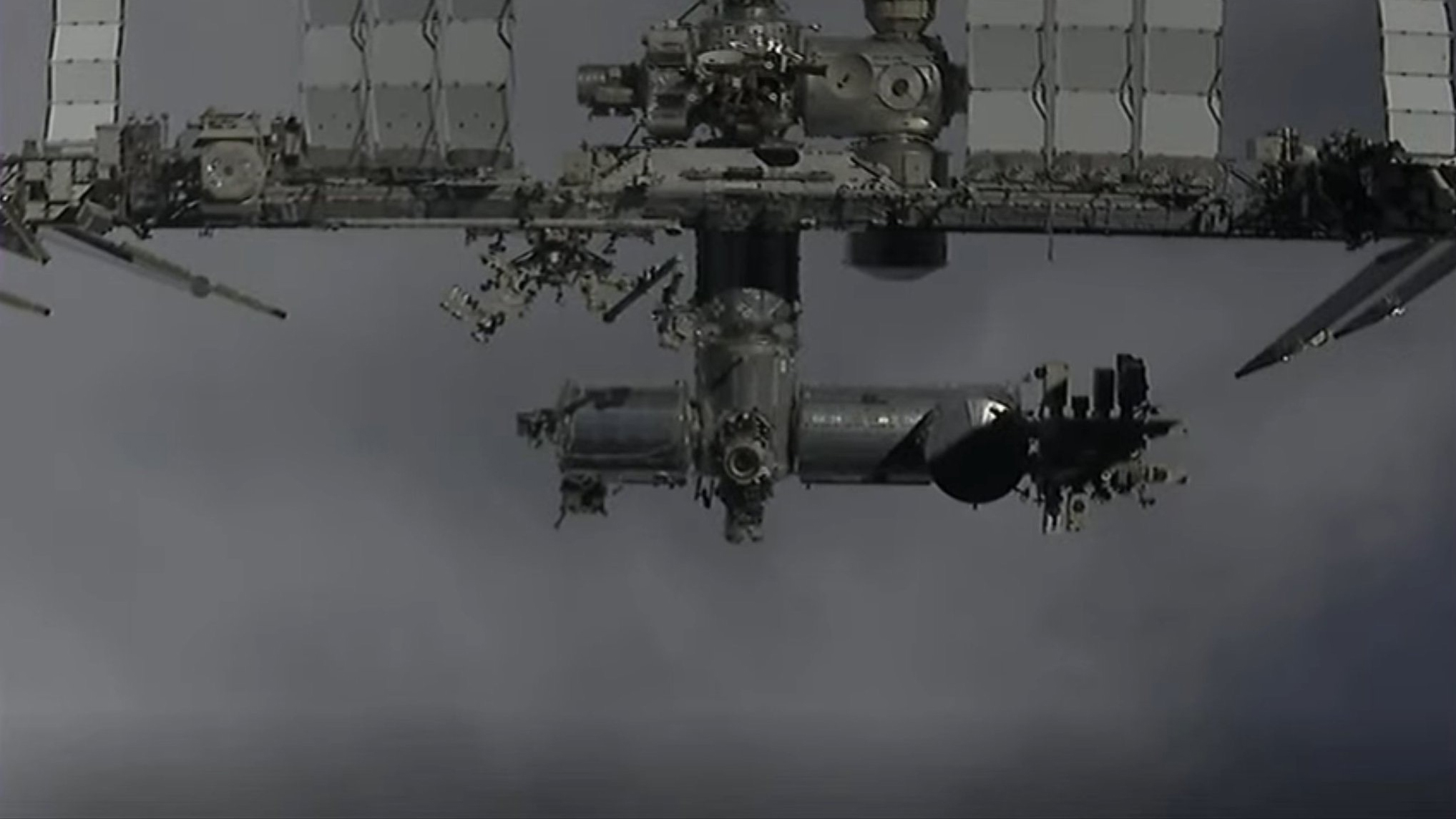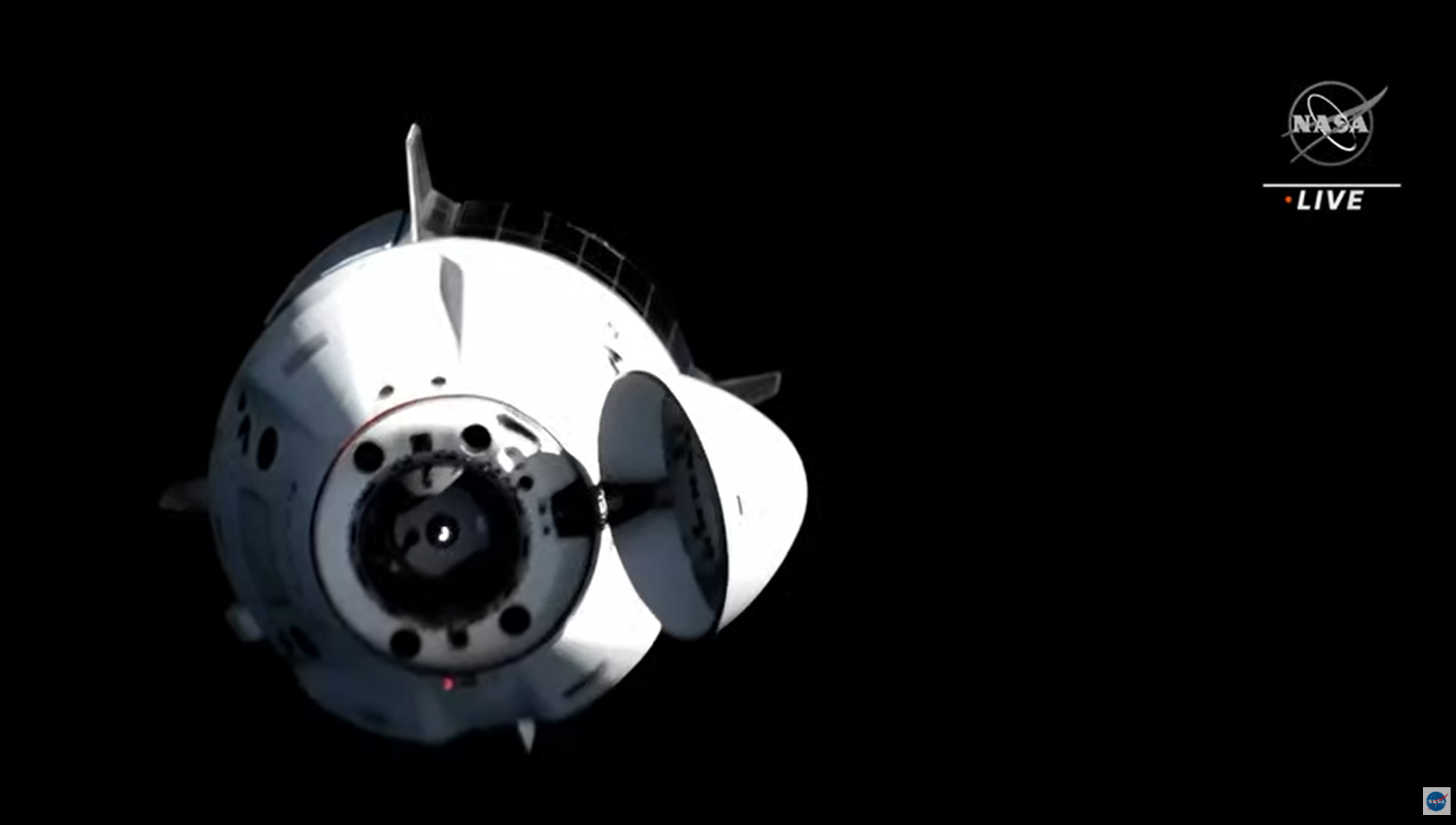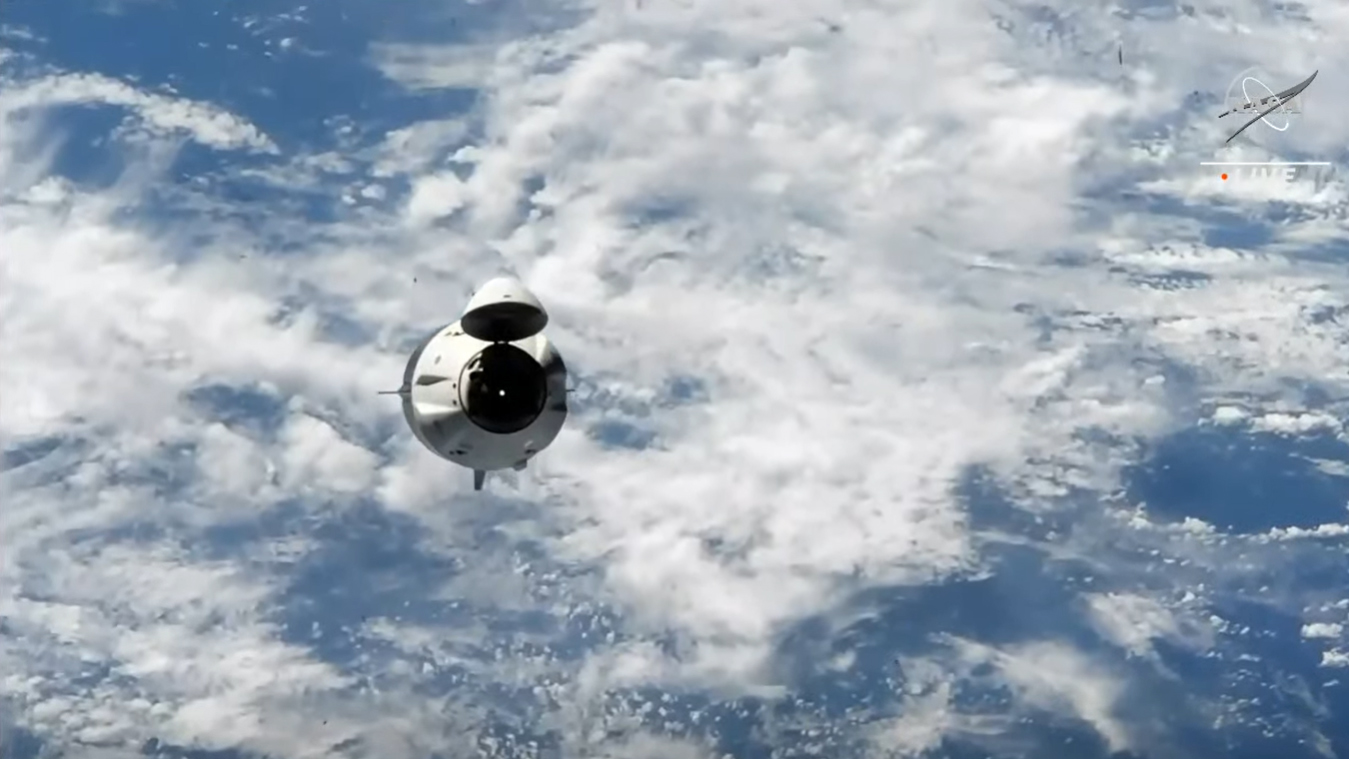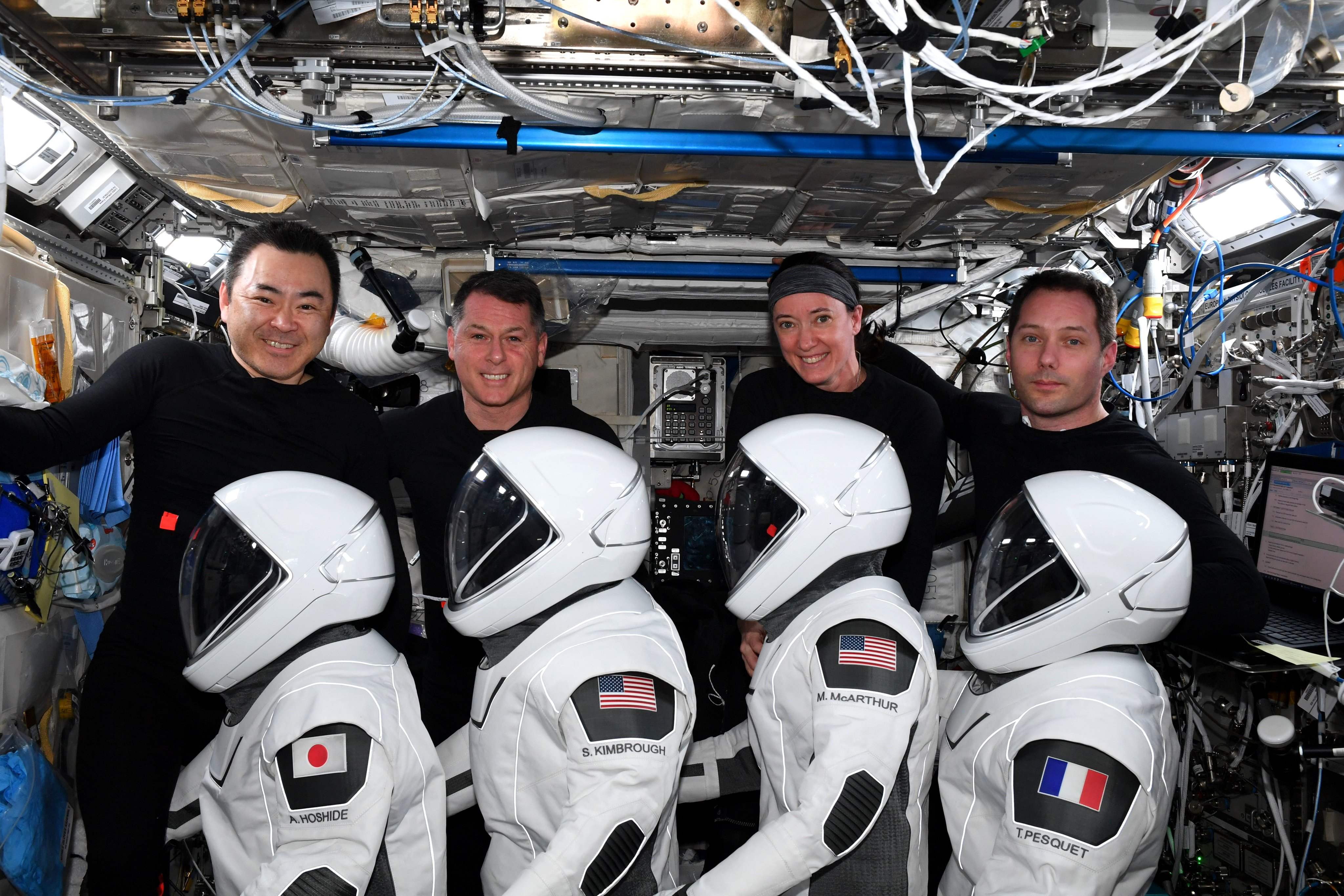SpaceX Crew-2 Dragon astronauts depart space station for return to Earth
Splashdown is set for tonight at 10:33 p.m. EST (0333 Nov. 9 GMT).
CAPE CANAVERAL, Fla. — SpaceX's second long-duration astronaut mission for NASA is nearing its end after a Crew Dragon capsule undocked from the International Space Station today (Nov. 8).
The company's Crew Dragon Endeavour, carrying the four astronauts of SpaceX's Crew-2 mission, is making the journey back to Earth for a planned splashdown tonight off the coast of Florida. The crew — NASA astronauts Shane Kimbrough and Megan McArthur, European Space Agency astronaut Thomas Pesquet and Japan Aerospace Exploration Agency astronaut Akihiko Hoshide — is wrapping up a six-month mission to the International Space Station.
Earlier on Monday, the hatches between Endeavour and the station closed on time at 12:13 p.m. EST (1713 GMT). The astronauts undocked from the station as planned at 2:05 p.m. EST (1905 GMT), then their Dragon spacecraft conducted a series of short burns to back away from the space station. They'll splash down in the Gulf of Mexico off the coast of Pensacola, Florida at 10:33 p.m. EST (0333 Nov. 9 GMT). You can watch it all live here and on the Space.com homepage, courtesy of NASA TV.
Live updates: SpaceX's Crew-2 astronaut mission splashdown



"It's been great to be part of your team," NASA astronaut Mark Vande Hei, who remained aboard the station, told the Crew-2 astronauts as they departed. "Get home safely."
"We learned a lot from you and know you're going to treat Crew-3 really well and let us know if we can do anything for you," Kimbrough radioed back. "Take care and fly safe."
Monday's Dragon departure was moved ahead of Crew-3's expected launch due to weather issues and a minor medical issue concerning one of the four astronauts who will take the next six-month stint in orbit.
Get the Space.com Newsletter
Breaking space news, the latest updates on rocket launches, skywatching events and more!
Related: SpaceX's Dragon space toilet is off limits for Crew-2 astronauts
Following their successful undocking, the Crew-2 astronauts performed a fly-around maneuver, the first of its kind since the shuttle era. During this maneuver, which is scheduled to take an hour and a half, the crew will photograph the exterior of the space station. The resulting photos will enable teams to examine areas of the station that aren't normally in view of the orbital outpost's cameras; the maneuver will also test the Dragon's navigation sensors.

The Crew-2 astronaut quartet spent six months in space as part of SpaceX's second long-duration crewed flight after launching in April atop a Falcon 9 rocket. That flight was supposed to be followed by the company's third astronaut mission, Crew-3, which was originally scheduled to launch on Oct. 31.
The Crew-3 Dragon, called Endurance, is still waiting to get off the ground. A series of delays prompted NASA to bring the Crew-2 astronauts home before sending up their replacements. The Crew-3 astronauts, NASA's Raja Chari, Tom Marshburn, Kayla Barron and Germany's Matthias Maurer will now launch to the space station on Nov. 10, if all goes as planned. Liftoff is set for 9:03 p.m. EST (0203 Nov. 11 GMT).
SpacX's Crew-3 astronauts arrived in Florida on Oct. 26 and spent the next few days running through the final launch procedures ahead of climbing into their Dragon. Poor weather along the rocket's planned flight path and a minor medical issue with a crewmember have delayed the launch from its Oct. 31 target.
Switching flights

Each Crew Dragon capsule can only stay in orbit for approximately 210 days in space before it must return to Earth. This is because the craft's sensitive hardware is constantly bombarded with radiation while attached to the orbital outpost, and that can overwhelm the more sensitive components, like those found in solar arrays..
Since the Crew-2 astronauts were approaching the 200-day mark, NASA and SpaceX decided that they would try to bring them home before launching Crew-3. This would trigger an indirect handover of the station between the crews.
Fellow NASA astronaut Mark Vande Hei is still on station, so he will be able to help get the Crew-3 astronauts (three of which have never flown in space before) acclimated to life in microgravity, something that the Crew-2 astronauts would have done had Crew-3 launched before their departure.
Recovery efforts
When Endeavor undocked from the International Space Station, both craft were sailing 259 miles above Chile. The crew's flight home is expected to last approximately 8.5-hours, as the Dragon spacecraft conducts a series of carefully choreographed departure burns before its final deorbit burn.
Under parachutes and the cloak of darkness, Dragon will descend, touching down right on time in the Gulf of Mexico, just south of Pensacola, Florida. NASA and SpaceX recovery teams were expecting ideal weather conditions, with calm seas and light winds.
The capsule is slated to splash down at 10:33 p.m. EST (0333 GMT on Tuesday, Nov. 9), and SpaceX's fast boats will be the first on the scene, arriving about 10 minutes later. One of SpaceX's Dragon recovery ship will use its onboard recovery systems to hoist the Dragon out of the water.
Once the Dragon is safe to approach, recovery team members will open the hatch and extract the crew. After exiting the Dragon, the crew members will be checked out by medical officials, then board a helicopter to take them back to shore before another plane will fly them back to Houston.
Editor's note: NASA is providing live coverage of SpaceX's Crew-2 astronauts returning to Earth. You can watch it live here, courtesy of NASA TV.
Follow Amy Thompson on Twitter @astrogingersnap. Follow us on Twitter @Spacedotcom or Facebook.
Join our Space Forums to keep talking space on the latest missions, night sky and more! And if you have a news tip, correction or comment, let us know at: community@space.com.

Amy Thompson is a Florida-based space and science journalist, who joined Space.com as a contributing writer in 2015. She's passionate about all things space and is a huge science and science-fiction geek. Star Wars is her favorite fandom, with that sassy little droid, R2D2 being her favorite. She studied science at the University of Florida, earning a degree in microbiology. Her work has also been published in Newsweek, VICE, Smithsonian, and many more. Now she chases rockets, writing about launches, commercial space, space station science, and everything in between.









